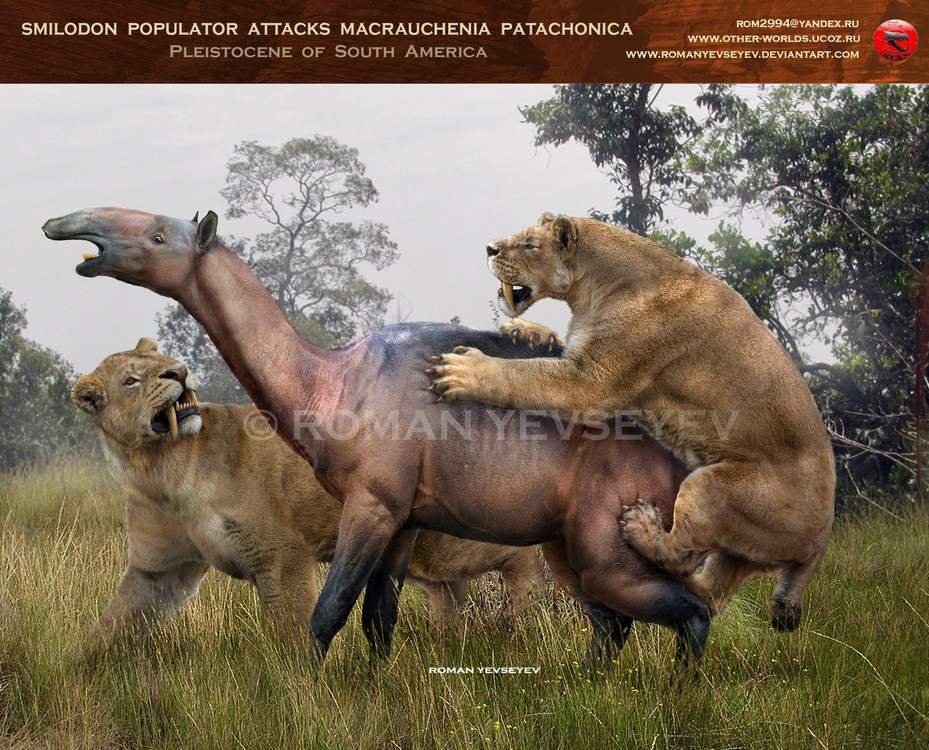Post by dinosauria101 on Jun 9, 2019 9:12:58 GMT 5
Smilodon populator (pride of 6)
Smilodon, often called a sabertoothed cat or wrongly a saber-toothed tiger, is an extinct genus of machairodonts. This saber-toothed cat was endemic to North America and South America, living from near the beginning through the very end of the Pleistocene epoch (2.5 mya—10,000 years ago). Smilodon populator ("Smilodon the Devastator"), 1 million-10,000 years ago; occurred in the eastern parts of South America and was the largest species of all machairodonts. It was much larger than its cousins, S. fatalis and S. gracilis, possessing a massive chest and front legs, and is the largest known variety of saber-toothed cat. It was more than 1.40 m (55 in) high at the shoulder, 2.6 m (100 in) long on average and had a 30 cm (12 in) tail. Smilodon populator was substantially heavier and larger than any extant felid, with a body mass range of 220–360 kg. Particularly large specimens of S. populator almost certainly exceeded 400 kg in body mass. Its upper canines reached 30 cm (12 in) and protruded up to 17 cm (6.7 in) out of the upper jaw. Genetic evidence suggests that Smilodon populator and other members of the genus diverged from the main lineage of modern cats (subfamily Felinae) around 14-18 million years ago.

American Mastodon - Mammut americanum
Mastodons are any species of extinct proboscideans in the genus Mammut (family Mammutidae), distantly related to elephants, that inhabited North and Central America during the late Miocene or late Pliocene up to their extinction at the end of the Pleistocene 10,000 to 11,000 years ago. Mastodons lived in herds and were predominantly forest dwelling animals that fed on a mixed diet obtained by browsing and grazing with a seasonal preference for browsing, similar to living elephants. M. americanum, the American mastodon, is the youngest and best-known species of the genus. They disappeared from North America as part of a mass extinction of most of the Pleistocene megafauna, widely believed to have been caused by overexploitation by Clovis hunters, and possibly also by climate change. Modern reconstructions based on partial and skeletal remains reveal that mastodons were very similar in appearance to elephants and, to a lesser degree, mammoths, though not closely related to either one. Compared to mammoths, mastodons had shorter legs, a longer body and were more heavily muscled, a build similar to that of the current Asian elephants. The average body size of the species M. americanum was around 2.3 m (7 ft 7 in) in height at the shoulders, corresponding to a large female or a small male; large males were up to 2.8 m (9 ft 2 in) in height. Among the largest male specimens, the 35-year-old AMNH 9950 was 2.89 m (9.5 ft) tall and weighed 7.8 tonnes (7.7 long tons; 8.6 short tons), while another was 3.25 m (10.7 ft) tall and weighed 11 tonnes (11 long tons; 12 short tons).

Credit to Wikipedia
Smilodon, often called a sabertoothed cat or wrongly a saber-toothed tiger, is an extinct genus of machairodonts. This saber-toothed cat was endemic to North America and South America, living from near the beginning through the very end of the Pleistocene epoch (2.5 mya—10,000 years ago). Smilodon populator ("Smilodon the Devastator"), 1 million-10,000 years ago; occurred in the eastern parts of South America and was the largest species of all machairodonts. It was much larger than its cousins, S. fatalis and S. gracilis, possessing a massive chest and front legs, and is the largest known variety of saber-toothed cat. It was more than 1.40 m (55 in) high at the shoulder, 2.6 m (100 in) long on average and had a 30 cm (12 in) tail. Smilodon populator was substantially heavier and larger than any extant felid, with a body mass range of 220–360 kg. Particularly large specimens of S. populator almost certainly exceeded 400 kg in body mass. Its upper canines reached 30 cm (12 in) and protruded up to 17 cm (6.7 in) out of the upper jaw. Genetic evidence suggests that Smilodon populator and other members of the genus diverged from the main lineage of modern cats (subfamily Felinae) around 14-18 million years ago.

American Mastodon - Mammut americanum
Mastodons are any species of extinct proboscideans in the genus Mammut (family Mammutidae), distantly related to elephants, that inhabited North and Central America during the late Miocene or late Pliocene up to their extinction at the end of the Pleistocene 10,000 to 11,000 years ago. Mastodons lived in herds and were predominantly forest dwelling animals that fed on a mixed diet obtained by browsing and grazing with a seasonal preference for browsing, similar to living elephants. M. americanum, the American mastodon, is the youngest and best-known species of the genus. They disappeared from North America as part of a mass extinction of most of the Pleistocene megafauna, widely believed to have been caused by overexploitation by Clovis hunters, and possibly also by climate change. Modern reconstructions based on partial and skeletal remains reveal that mastodons were very similar in appearance to elephants and, to a lesser degree, mammoths, though not closely related to either one. Compared to mammoths, mastodons had shorter legs, a longer body and were more heavily muscled, a build similar to that of the current Asian elephants. The average body size of the species M. americanum was around 2.3 m (7 ft 7 in) in height at the shoulders, corresponding to a large female or a small male; large males were up to 2.8 m (9 ft 2 in) in height. Among the largest male specimens, the 35-year-old AMNH 9950 was 2.89 m (9.5 ft) tall and weighed 7.8 tonnes (7.7 long tons; 8.6 short tons), while another was 3.25 m (10.7 ft) tall and weighed 11 tonnes (11 long tons; 12 short tons).

Credit to Wikipedia





